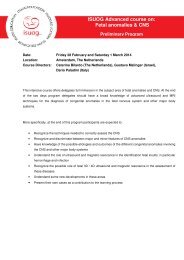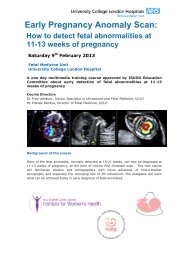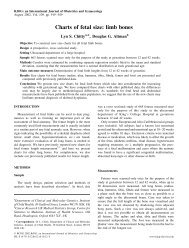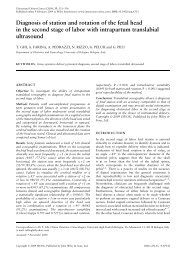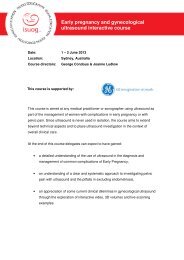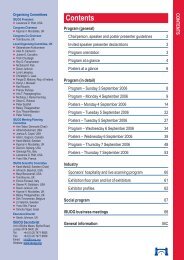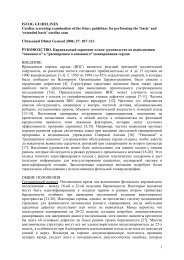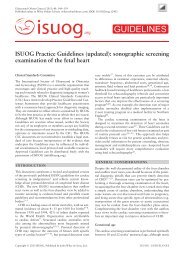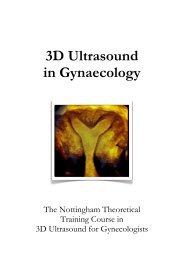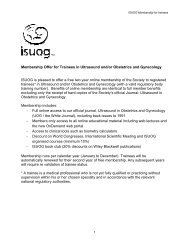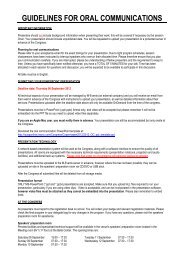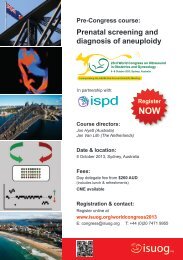Pre-Congress course: Prenatal screening and diagnosis of ... - isuog
Pre-Congress course: Prenatal screening and diagnosis of ... - isuog
Pre-Congress course: Prenatal screening and diagnosis of ... - isuog
You also want an ePaper? Increase the reach of your titles
YUMPU automatically turns print PDFs into web optimized ePapers that Google loves.
<strong>Pre</strong>-<strong>Congress</strong> <strong>course</strong>: <strong>Pre</strong>natal <strong>screening</strong> <strong>and</strong> <strong>diagnosis</strong> <strong>of</strong> aneuploidyThe most significant changes in aneuploidy <strong>screening</strong> in recent years have involved thedevelopment <strong>of</strong> novel genetic technologies. Microarrays are used to define genetic anomaliesafter amniocentesis <strong>and</strong> have a greater degree <strong>of</strong> resolution than st<strong>and</strong>ard cytogenetic tests;non-invasive prenatal testing <strong>of</strong>fers a highly sensitive means <strong>of</strong> <strong>screening</strong> for Down syndrome,allowing women to avoid amniocentesis – but does not detect the same range <strong>of</strong> aneuploidy asthat seen with a st<strong>and</strong>ard cytogenetic test.We need to define the place <strong>of</strong> these technologies in the <strong>screening</strong> paradigm. We also need toevaluate the role <strong>of</strong> current <strong>screening</strong> techniques <strong>and</strong> whether these need to change toaccommodate the new technologies.This <strong>course</strong> will:Review current implementation <strong>of</strong> ultrasound in <strong>screening</strong> for Down syndrome.Describe the advantages <strong>and</strong> limitations <strong>of</strong> novel molecular tools for prenatal <strong>screening</strong><strong>and</strong> <strong>diagnosis</strong>.Define indications for these tools – based on current ultrasound <strong>screening</strong> protocols.Describe ways in which ultrasound <strong>screening</strong> can adapt to the changing environment <strong>of</strong>molecular based testing.
11.30 – 11.50 aCGH array for “routine” fetal karyotyping: clinical experience11.50 – 12.00 Discussion12.00 – 13.00 LunchForget the trees, concentrate on the wood: non-invasive prenatal testing13.00 – 13.20 Sequencing for NIPT: techniques, technologies, applications <strong>and</strong>limitations13.20 – 13.40 Non-invasive testing: a summary <strong>of</strong> test efficacy13.40 – 14.00 Limited karyotyping: what we will miss14.00 – 14.20 Combined first trimester biochemistry, NIPT or both?14.20 – 14.40 Discussion14.40 – 15.10 C<strong>of</strong>fee breakAdjusting to the new clinical paradigm15.10– 15.30 First trimester <strong>screening</strong> for neural tube defects15.30 – 15.50 Screening for adverse pregnancy outcomes at 12 weeks15.50 – 16.10 Diagnosing cardiac defects at 12 weeks: tips <strong>and</strong> tricks for thesonographer16.10 – 16.30 Back to markers: non-invasive testing or arrays after a positive 20 weekanomaly scan?16.30 – 16.40 Discussion



